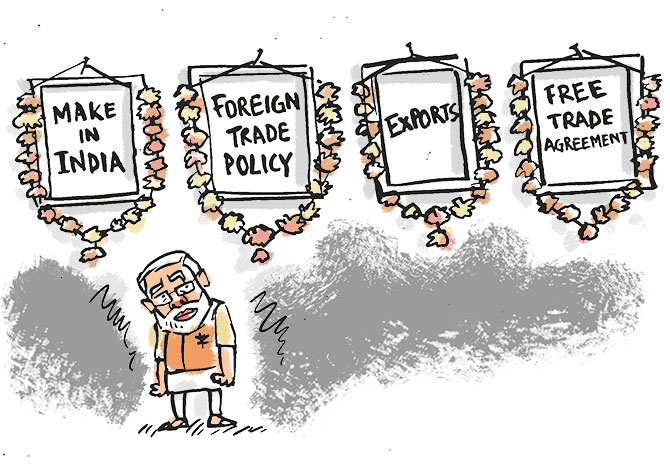From Sacred Ram Temple Leak, Neet Paper Leak, To Tipping Roofs And Collapsing Bridges; Modi 3.0’s ‘Reform, Perform, Transform’ Turned India Into The World’s 5th Largest Economy, One Collapse At A Time!

Modi’s 3.0 Term On A “Leaky” Start
Modi has already taken small steps into his 3.0 term, and just a few days back, the Hon President of India, Droupadi Murmu, made a fascinating speech while addressing Parliament’s joint session, stating that the pledge of reform, performance, and transformation has made India the fastest-growing economy in the world. She further said, “My government is working towards making India the third-largest economy in the world.”
There is something to be said about the speech, but that shall come a bit later.
First, it’s changing seasons. We know that, but what we did not know was that instead of merely a change in weather patterns, we would also witness a series of events bringing with them a plethora of “leaks” and chaos due to structural “collapses.”
 Modi’s Spell On India’s Infrastructure
Modi’s Spell On India’s Infrastructure
One of the many feats the Modi government has so far proudly proclaimed is that it has taken India’s infrastructure to ‘another level.’
Yet another big feat that the Modi government proudly achieved (it had to be done, finished, and buffed to shine before the elections) was the construction of the Ram Mandir.
Its inauguration was a gala affair that saw who’s who jostling to be seen at the opening, almost 7000 high-profile celebrities patiently waiting to give ‘precious’ media bytes.
However, what is the stark reality in our country?
Just as the rain gods appear on the horizon, with the first rains, they expose the ‘integrity, strength, and corruption’ of our finest, newly built roads.
However, this time, it has dealt an even heavier blow and shed a pious light on the Ram Mandir itself, built at a whopping cost of ₹1,800 crore.
Acharya Satyendra Das, the chief priest of the Ram Temple in Ayodhya, reported significant leakage from the roof directly above his seating area in front of the idol of Ram Lalla.
Hence, despite the initial celebrations, concerns have arisen about the durability of the structure, which was intended to symbolize a path toward national development. How ironic indeed!
According to Nripendra Mishra, the temple construction committee chairman, while acknowledging the issue, explained that it is expected because the ‘Guru Mandap’ is exposed to the sky and the completion of the Shikhar (spire) will cover this opening. He added that work on the first floor is in progress and the conduit will be closed once completed.
However, despite these assurances, the chief priest expressed scepticism about the committee’s claim that the entire temple construction would be completed by December 2024, stating that it was “impossible” given the amount of work still required.
This raises an important question: Why was there such a frenzy to inaugurate the Ram Temple much ahead of schedule, even when a critical portion of construction that directly exposed the area in front of the idol of Ram Lalla remained incomplete?
Shouldn’t this have been the top priority? Why wait for the rains to expose this glaring audacity?
What respect have we ultimately shown?
Therefore, it is very much in keeping with the seasonal monsoon to say that Modi’s 3.0 has started with many a “leaking” controversy.
From the sacred Ram Temple roof leak to the NEET paper leak, which has left the student community crying foul and exposed the ‘rot’ in the higher echelons of India’s education system, to the collapsing roof of India’s capital and busiest airport, and newly constructed bridges, or even those under construction (in Bihar, the 5th incident in 11 days), all point to ‘critical faults and deficits’ in India’s infrastructure.
These include the Delhi Airport (T1) roof collapse, the Jabalpur airport roof collapse, the abysmal condition of Ayodhya’s new roads, Ram Mandir roof leakage, cracks in the Mumbai Trans Harbour Link road, the collapse of 13 new bridges in Bihar in 2023 and 2024, the submerging of the Pragati Maidan Tunnel, and the Morbi bridge collapse tragedy in Gujarat.

The Bharatiya Janata Party, in its 2019 election manifesto, promised that it would ramp up India’s physical infrastructure, calling it “the backbone of New India.”
It also claimed that since 2014, the Narendra Modi-led government had remedied the “policy paralysis and corruption” that plagued the sector under the previous Congress government and pledged to continue with the “fast pace” of infrastructural development, laying out specific targets on several fronts.
Hence, what has come of these promises?
Highways
One of the key promises was to double the length of national highways by 2022. It also promised to add 60,000 km of national highways in the next five years.
But these two promises seem to be at odds; why?
Because in 2019, the length of India’s national highways was 1,30,667 km and doubling it would require constructing more than twice the length the BJP promised.
According to the latest available data, even if we take 2014 as the base year, the length of India’s national highways network has not doubled under the BJP.
In March 2014, India had 91,287 km of national highways; the corresponding figure in March 2023 was 1,75,019 km.
Therefore, the Modi government might not achieve its target of constructing 60,000 km of national highways by 2024.
In the first four years of its second tenure, the government built 44,352 km at an average of 11,088 km per year.
However, while the Modi government might fall short of its stated targets, the pace of highway construction in the past decade has been higher than under the Congress from 2004 to 2014.
Critics, however, have accused the Modi government of inflating the numbers by shifting to a new formula that portrays the pace of construction in a better light.
 Railways
Railways
Railways are the backbone of the widespread nation; let us look at the Modi government’s claims here –
The BJP’s 2019 manifesto promised “all efforts to ensure electrification of all railway tracks” and the completion of the dedicated freight corridor project by 2022.
Both are yet to happen.
At that time, railway minister Ashwini Vaishnav, responding to a query in Lok Sabha on the expected timeframe for the completion of electrification, said it “cannot be ascertained at this stage.”
However, the rate of electrification in the BJP era has been higher than in 2004-’14 when the Congress was in power.
Even as the government has expanded the network of high-end trains – as promised in the manifesto – the last five years have been marked by Indian Railways’ finances plunging like never before.
As for the dedicated freight corridors, only the eastern leg has been completed. As of December 2023, the construction of 330 km of the 1,506-km long western corridor is still pending.
Air Travel
The BJP manifesto also promised to expand India’s air travel network by doubling the number of functional airports.
That also has not materialized—according to official data presented in Parliament, the number of functional airports in the country increased from 101 in 2019 to 148 in December 2023.
All around, the BJP government has made 74 airports freshly operational since coming to power in 2014.
According to the Ministry of Civil Aviation’s annual reports, the Congress-led government, on the other hand, built 44 new airports between 2004 and 2014.
Ports
On the coastal infrastructure front, the BJP manifesto promised a doubling of India’s port capacity.
In 2019, the country’s port capacity stood at 1,534 metric tonnes per annum, which has since increased to 2,600 metric tonnes per annum, an increase of around 70% (a shout out to Adani Ports)
Optical Fibre Network
Among the BJP’s infrastructure development promises in its 2019 manifesto was to connect every gram panchayat with a high-speed optical fibre network by 2022.
Government data shows that as of December 2023, 2,08,635 of the approximately 2.5 lakh panchayats in the country have been connected.
According to data presented in Parliament, the length of optical fibre laid in India has increased from 10.62 lakh km in 2014 to 38.86 lakh km in September 2023.
 Tallying The Numbers
Tallying The Numbers
The above data can help gauge whether the Modi government achieved the targets it had set. More importantly, the outcomes are in front of all to see!
As more structural collapses are reported with each passing day, the critical question is, where is the lag, and who is to be held responsible for the ‘corruption’ that has paved the way for ‘criminal negligence’?
Those who were given contracts under the Modi government, those who oversaw the work and passed on ‘quality checks,’ and, more importantly, whose money has been squandered on these shoddy projects?
Think.
Last but not least, the finer aspects of the speech by the Hon President of India, Droupadi Murmu, while addressing Parliament’s joint session, stated that the pledge to reform, perform, and transform has made India the fastest-growing economy in the world, further claiming, “My government is working towards making India the third largest economy in the world.”
No previous Presidents of India have ever referred to “my government,” which is in direct violation, as a President’s role is to “not take sides” but to represent the entire Parliament.
Hence, is this a case of ‘mouth piecing’ rather than an actual representation?
Think again.




